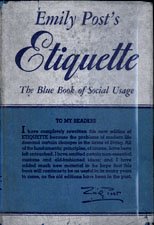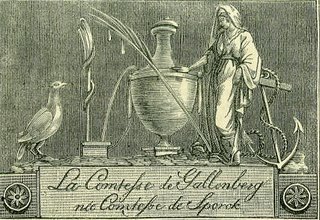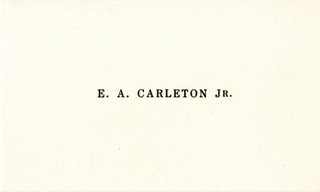In her last letter
I remembered, vaguely, a small pile of Dad’s visiting cards forgotten in the back of the third-down, hard-to-open drawer of his old bureau. The bureau had been evacuated with us from Beirut, in 1975, when “the troubles” began, and arrived by steamship to our new home in Florida. I’d open the drawers late at night, quietly, to try and look into a past that was mine, but unknown.
Last week, by email, I asked Mom for a few of them. She wrote, by mail, enclosing two.
“As you’ve requested, here are two of Dad’s visiting cards. Remark the printing is in relief”.
I ran my finger over the small, block letters. The restrained sentences in her short letter exposed her long, quiet grief over Dad’s death, almost 30 years ago. Her attention to that detail and gentle imperative told me she had admired his vision of things, his aesthetic choices, and rediscovered them on this small piece of thick paper stock.
The simplicity of the design was powerful. I loved the font, and the slightly-raised lettering, black, with a dark-blue sheen. I tried to imagine him standing at a printer’s shop in another country, selecting it, and carrying it about in his jacket pocket, or perhaps even a case just for that purpose. The card was something of his I could hold, but entirely an enigma.
With no idea of how to use visting cards, or even how they were used, I opened (for the first time) a 1922 edition of Emily Post’s “Etiquette”. Chapter X is simply titled “Cards and Visits” and I took a dizzying walk into a labyrinthine, and perhaps thankfully bygone time of complex codes of behavior.

Skimming over “HOW TO ENTER A ROOM”
- The way not to enter a drawing-room is to dart forward and then stand awkwardly bewildered and looking about in every direction. A man of the world stops at the entrance of the room for a scarcely perceptible moment, until he perceives the most unencumbered approach to the hostess, and he thereupon walks over to her
(but I sometimes amble in, and certainly often dart; awkward is not unknown to me)
and “HOW TO SIT GRACEFULLY”
…one should not perch stiffly on the edge of a straight chair, nor sprawl at length in an easy one. The perfect position is one that is easy, but dignified. … An arm a-kimbo is not a graceful attitude, nor is a twisted spine!
(but for me, comfort and good conversation are synonymous),
In the next section, I found a resonating tenor with the design of Dad’s card.
A Card's Size and Engraving
The engraving most in use to-day is shaded block. Script is seldom seen, but it is always good form and so is plain block, but with the exception of old English all ornate lettering should be avoided.

The personal card is in a measure an index of one’s character. A fantastic or garish note in the type effect, in the quality or shape of the card, betrays a lack of taste in the owner of the card.
Surely Dad would laugh at all this, and wasn’t following Chapter X, but his own taste and expression of his personal flair. Maybe with inherited, societal, sensibilities. Perhaps the simple style had a distinctly American flavor.
This flavor would be at odds with “Chambers’ Book of Days”, an 1872 book whose subtitle includes the alluring invitation “A Miscellany of Popular Antiquities…and Curiosities and Oddities of Human Life and Character”.

Under “Visiting Cards of the 18th Century” Robert Chambers, social historian, writes that:
From the lady of fashion…to the man of business, and even the postman, who presents his card on Christmas-day morning, these little square bits of card-board have become an established institution of polite society. The last century has, however, left us an example of how to make these trifles matters of taste and art.

The good, quiet, moral society of Vienna, Dresden, and Berlin, in which, according to contemporary historians, it was so pleasant to live, piqued itself upon its delicacy of taste; and instead of our insipid card, with the name and quality of the visitor printed upon it, it distributed real souvenirs, charming vignettes, some of which are models of composition and engraving.
He offers examples of the un-insipid and the charming.
The lost artists of etiquette comment on the lost art of practicing etiquette, and diplomatically refer to contemporary times as an “era of informality”, their kind way of saying we’ve not only trashed, but abandoned, the rules of civilized society.
Almost, but not quite.
I’m not clear on the use of visting cards, today. Or even in the past "era of formality". There are flashes of scenes that include butlers in overstarched waistcoasts proferring silver trays whisked away on silent footsteps to the inner world of a drawing room. Thank PBS’ Masterpiece Theatre for that. Not what Dad would have used them for in hot, dusty streets of Lebanon, not matter how much Beirut was a Paris to its Middle East.
I don’t know yet how he used them, but intend to find out. In part by using them myself.
I drove, with the old visiting card carefully placed in an envelope, to the best printer in town, (well, it is upstate and there is only one within a drivable radius, but I was comforted to see that the Hudson Chamber of Commerce had bestowed on him “Best Business Man of the Year, 2006”) and held out the card. “Same design, exactly, please, but with my name.”
Some analyses later (“…font, looks like century expanded, old-style thermography, unusual size, definitely not American business card size…”) I left the card behind with promises I’d exacted from the father-son printing team it would be handled carefully.
I’m not sure where I’ll use the card, or how useful it will be, with only the naked, bold statement of my name standing out in relief. I’ll let you know. But it will draw out conversation, and memories of Dad.
The card is more than something of his, it is something of him.


2 Comments:
MH - Blogger! Love everything you've done. And love the name you've given it too. And the poetic prose, the moody pics, the look and feel's all cozy - like library, fireside cozy. Well done, may it grow in hearts and readership in 2007!
And I love the calling card musing. In the hillstations of Darjeeling, Shimla, they were left with butlers in the homes of the Brits as a way of announcing they'd come up from the plains for the season...
Also, not sure if this is unrelated or not, but one's stationery traditionally mentioned address only - never name. So maybe the calling card was the companion piece?
Much to ponder : )
C
This was a beautiful story. Let's bring back the calling card tradition! And salons!
Post a Comment
<< Home